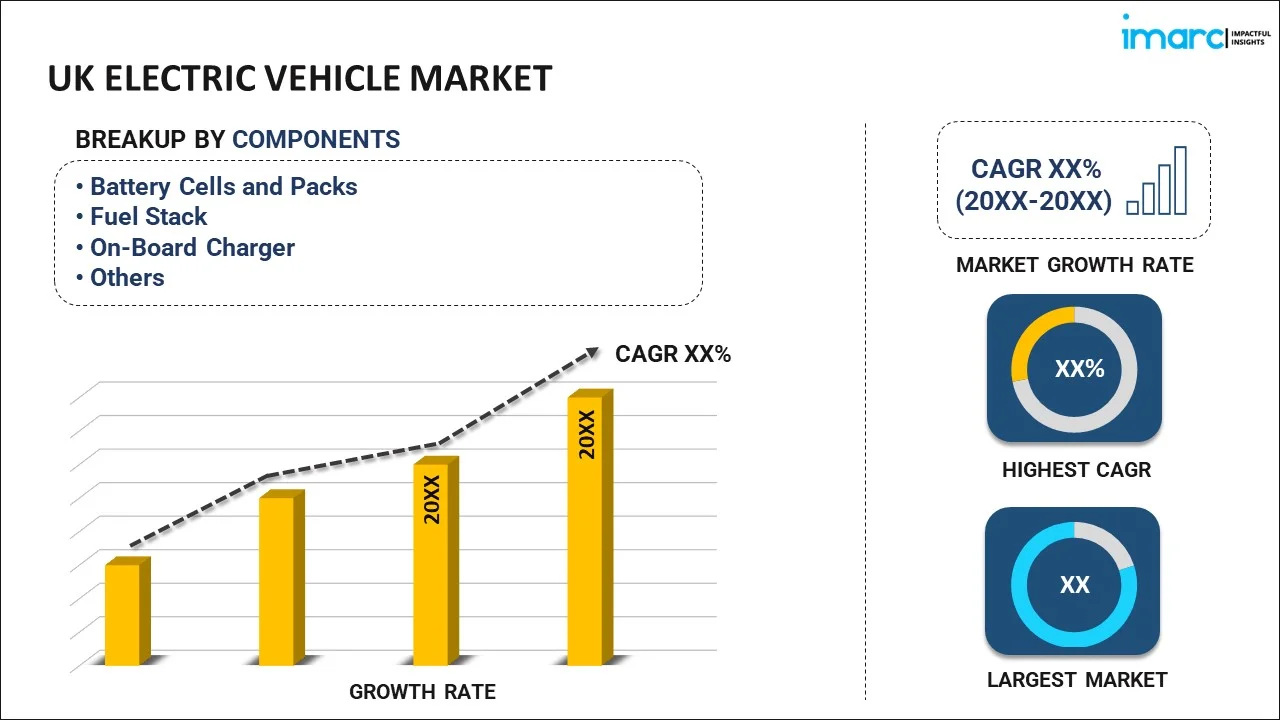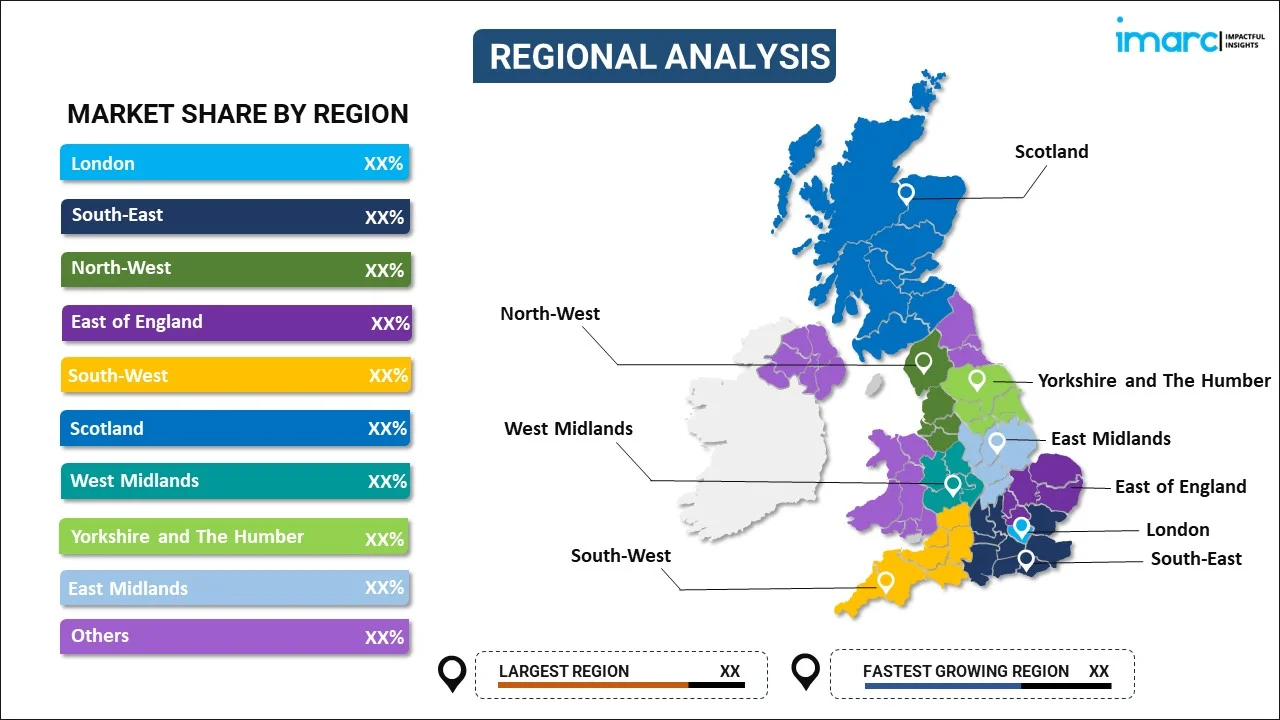
UK Electric Vehicle Market Report by Component (Battery Cells and Packs, Fuel Stack, On-Board Charger, Electric Motor, Brake, Wheel and Suspension, Body and Chassis, and Others), Propulsion Type (Battery Electric Vehicle (BEV), Fuel Cell Electric Vehicle (FCEV), Plug-In Hybrid Electric Vehicle (PHEV)), Vehicle Type (Passenger Vehicles, Commercial Vehicles, and Others), and Region 2024-2032
UK Electric Vehicle Market Overview:
The UK electric vehicle (EV) market is projected to exhibit a growth rate (CAGR) of 27.20% during 2024-2032. Stringent emissions regulations, government incentives like grants and tax benefits, improvements in charging infrastructure, technological advancements in battery technology, decreasing EV production costs, partnerships for smart charging solutions, government's ban on new petrol and diesel car sales, and increasing consumer awareness of environmental benefits are significant drivers for the market.
|
Report Attribute
|
Key Statistics
|
|---|---|
|
Base Year
|
2023 |
|
Forecast Years
|
2024-2032
|
|
Historical Years
|
2018-2023
|
| Market Growth Rate (2024-2032) | 27.20% |
UK Electric Vehicle Market Trends:
Stringent Emissions Regulations and Government Incentives
The UK electric vehicle (EV) market has seen a remarkable boost due to the strict emissions reduction rule. As per the industry reports, new petrol and diesel cars as well as vans will be banned from sale in the UK come 2035. These regulations, supported by strong government incentives such as grants and tax benefits for EV buyers, are surging the product adoption rates, which is another factor accelerating the market growth. Apart from this, the availability of schemes like the Plug-In Car Grant, which gives financial aid to consumers buying EVs, further lowering the upfront costs and boosting the market growth.
Improving Charging Infrastructure
The expansion and enhancement of charging infrastructure across the UK are crucial factors facilitating growth of EV market. Efforts to develop a comprehensive network of rapid charging stations address primary concerns among potential EV buyers. Range anxiety is a significant impediment to EV adoption, by strategically locating charging points in urban areas, such as highways and public spaces, the accessibility and convenience of charging electric vehicle can be greatly improved. This infrastructure development is supported by public and private investments. These investments ensure that EV owners can charge their vehicles quickly across the country.
Rapid Advancements in Battery Technology
Advances in battery chemistry and engineering have dramatically increased energy storage capacity, which has enabled customers to travel an entire day's journey on one charge. In addition, the development of fast-charging systems has significantly reduced the time needed for recharging the battery, which is further creating a positive outlook for the market growth. Moreover, these enhancements not only improve the performance and practicality of electric cars but also reduce ownership costs, and also help in improving battery lifespan and efficiency. With battery technology moving forward, the investments in research of new and lighter materials will help maintain the attractiveness and competitiveness of electric vehicles in the UK.
UK Electric Vehicle Market News:
- In 2024, Tesla regained its position as the leading battery electric vehicle (BEV) brand in the UK, surpassing BMW. This achievement came after a relatively quiet period at the end of 2023, which saw reduced Model 3 deliveries ahead of a refresh. The refreshed Model 3, known as the “Highland,” began deliveries in late January 2024, significantly boosting Tesla's sales figures. Additionally, Tesla announced record production and delivery numbers for the first quarter of 2024, with over 433,000 vehicles produced and 387,000 delivered globally.
- In 2024, Volkswagen announced its focus on expanding its ID. family of electric vehicles, which includes popular models like the ID.3 and ID.4. In January 2024, Volkswagen announced plans to increase production capacity for its electric vehicles to meet growing demand in the UK and other European markets. Additionally, Volkswagen has invested heavily in charging infrastructure, partnering with various stakeholders to improve the availability and convenience of charging stations.
UK Electric Vehicle Market Segmentation:
IMARC Group provides an analysis of the key trends in each segment of the market, along with forecasts at the country level for 2024-2032. Our report has categorized the market based on component, propulsion type, and vehicle type.
Component Insights:

- Battery Cells and Packs
- Fuel Stack
- On-Board Charger
- Electric Motor
- Brake, Wheel and Suspension
- Body and Chassis
- Others
The report has provided a detailed breakup and analysis of the market based on the component. This includes battery cells and packs, fuel stack, on-board charger, electric motor, brake, wheel and suspension, body and chassis, and others.
Propulsion Type Insights:
- Battery Electric Vehicle (BEV)
- Fuel Cell Electric Vehicle (FCEV)
- Plug-In Hybrid Electric Vehicle (PHEV)
A detailed breakup and analysis of the market based on the propulsion type have also been provided in the report. This includes battery electric vehicle (BEV), fuel cell electric vehicle (FCEV) and plug-in hybrid electric vehicle (PHEV).
Vehicle Type Insights:
- Passenger Vehicles
- Commercial Vehicles
- Others
The report has provided a detailed breakup and analysis of the market based on the vehicle type. This includes passenger vehicles, commercial vehicles, and others.
Regional Insights:

- London
- South East
- North West
- East of England
- South West
- Scotland
- West Midlands
- Yorkshire and The Humber
- East Midlands
- Others
The report has also provided a comprehensive analysis of all the major regional markets, which include London, South East, North West, East of England, South West, Scotland, West Midlands, Yorkshire and The Humber, East Midlands, and Others.
Competitive Landscape:
The market research report has also provided a comprehensive analysis of the competitive landscape. Competitive analysis such as market structure, key player positioning, top winning strategies, competitive dashboard, and company evaluation quadrant has been covered in the report. Also, detailed profiles of all major companies have been provided.
UK Electric Vehicle Market Report Coverage:
| Report Features | Details |
|---|---|
| Base Year of the Analysis | 2023 |
| Historical Period | 2018-2023 |
| Forecast Period | 2024-2032 |
| Units | Million Units |
| Scope of the Report | Exploration of Historical Trends and Market Outlook, Industry Catalysts and Challenges, Segment-Wise Historical and Future Market Assessment:
|
| Components Covered | Battery Cells and Packs, Fuel Stack, On-Board Charger, Electric Motor, Brake, Wheel and Suspension, Body and Chassis, Others |
| Propulsion Types Covered | Battery Electric Vehicle (BEV), Fuel Cell Electric Vehicle (FCEV), Plug-In Hybrid Electric Vehicle (PHEV) |
| Vehicle Types Covered | Passenger Vehicles, Commercial Vehicles, Others |
| Regions Covered | London, South East, North West, East of England, South West, Scotland, West Midlands, Yorkshire and The Humber, East Midlands, Others |
| Customization Scope | 10% Free Customization |
| Post-Sale Analyst Support | 10-12 Weeks |
| Delivery Format | PDF and Excel through Email (We can also provide the editable version of the report in PPT/Word format on special request) |
Key Questions Answered in This Report:
- How has the UK electric vehicle market performed so far and how will it perform in the coming years?
- What has been the impact of COVID-19 on the UK electric vehicle market?
- What is the breakup of the UK electric vehicle market on the basis of component?
- What is the breakup of the UK electric vehicle market on the basis of propulsion type?
- What is the breakup of the UK electric vehicle market on the basis of vehicle type?
- What are the various stages in the value chain of the UK electric vehicle market?
- What are the key driving factors and challenges in the UK electric vehicle?
- What is the structure of the UK electric vehicle market and who are the key players?
- What is the degree of competition in the UK electric vehicle market?
Key Benefits for Stakeholders:
- IMARC’s industry report offers a comprehensive quantitative analysis of various market segments, historical and current market trends, market forecasts, and dynamics of the UK electric vehicle market from 2018-2032.
- The research report provides the latest information on the market drivers, challenges, and opportunities in the UK electric vehicle market.
- Porter's five forces analysis assist stakeholders in assessing the impact of new entrants, competitive rivalry, supplier power, buyer power, and the threat of substitution. It helps stakeholders to analyze the level of competition within the UK Electric vehicle industry and its attractiveness.
- Competitive landscape allows stakeholders to understand their competitive environment and provides an insight into the current positions of key players in the market.
Need more help?
- Speak to our experienced analysts for insights on the current market scenarios.
- Include additional segments and countries to customize the report as per your requirement.
- Gain an unparalleled competitive advantage in your domain by understanding how to utilize the report and positively impacting your operations and revenue.
- For further assistance, please connect with our analysts.
 Inquire Before Buying
Inquire Before Buying
 Speak to an Analyst
Speak to an Analyst
 Request Brochure
Request Brochure
 Request Customization
Request Customization




.webp)




.webp)












